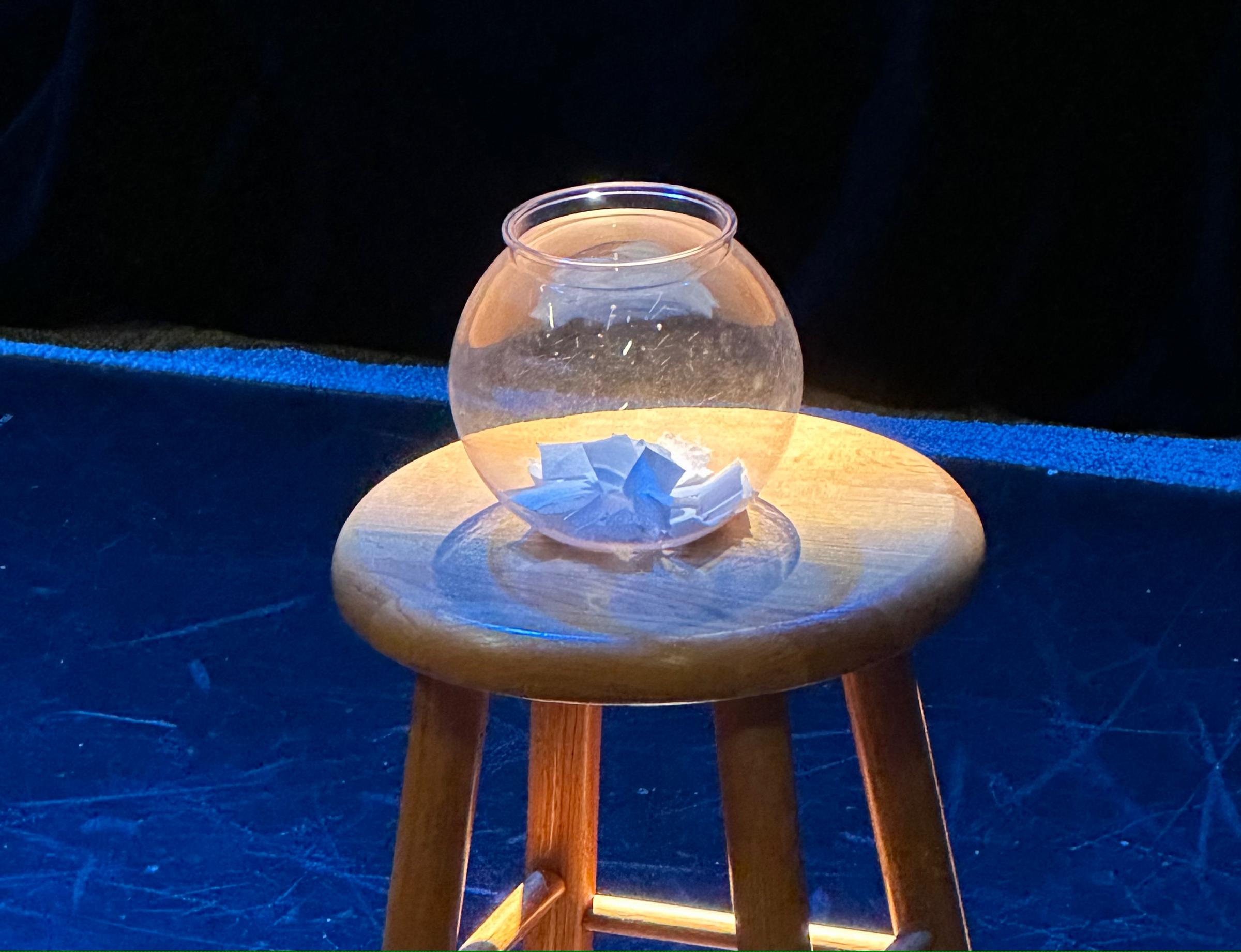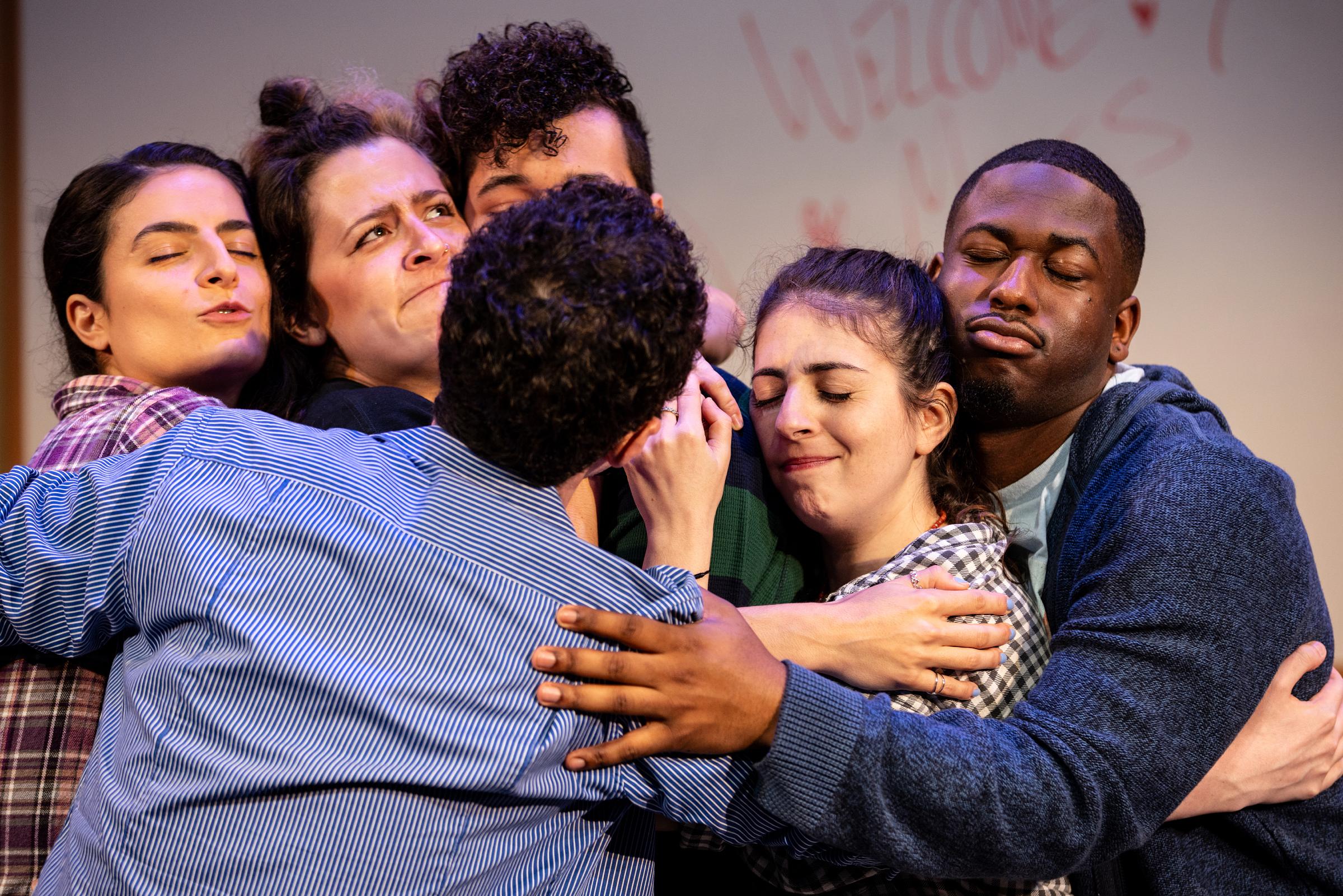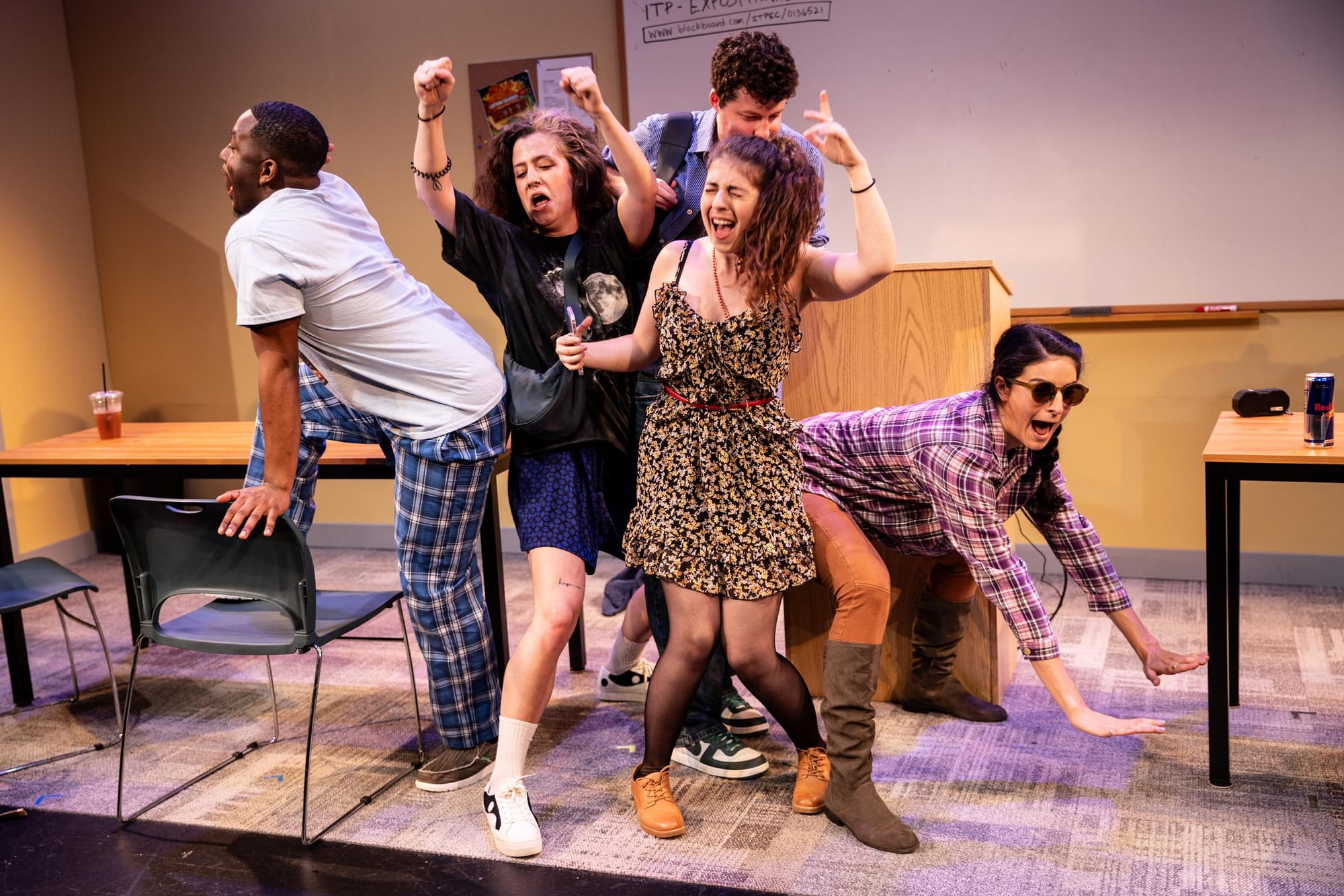“Give us a One Word Suggestion!” reads a sign on a table in the lobby of Jeffrey and Paula Gural Theatre at 502 West 53rd St. Before seeing What Else is True? — a new play written by David Rosenberg, directed by Adam Coy and Jake Bechkhard, and produced by the Egg and Spoon Theatre Collective, running now through Aug. 26 — audiences have the opportunity to write a word on a slip of paper and place it in a fishbowl that sits spotlit onstage, echoing a classic improv invitation.
Having just come from brunch, I slipped “mimosa” into the bowl and took my seat, excited to see how our suggestions were incorporated into the show.

What Else Is True?, as described on Egg and Spoon’s website, follows a improv team “at a large university in New York City” through the events of the 2010-11 school year. The piece is a bittersweet “comedy about the ecstasy — and impermanence — of friendship in college.” As the year goes on, cracks in those friendships widen into treacherous fissures that threaten to swallow up the entire group.
As a recent graduate, I’m still mourning the social connections and feeling of togetherness that began to fade as soon as I got my diploma. Rosenberg’s play twists the knife further, making my heart ache for the friendships that didn’t even make it that far.
But make no mistake: What Else Is True? is uproariously funny, and brimming with the cautious joy and delicate hope characteristic of a group of young adults still figuring out how to be themselves, and be in community with others, to varying degrees of success. As the characters navigate a competitive improv season, awkward self-actualization, and an array of silly, horny, and rough-edged interactions, I couldn’t help but laugh with them as much as I laughed at them. I don’t have an improv background, but Rosenberg’s characters are nonetheless not far off from myself and people I’ve known. It didn’t take long for them to steal my heart.
Those characters are skillfully portrayed by an incredible cast of performers, under the mesmerizing direction of Adam Coy and Jake Beckhard. The improv exercises they perform throughout the play are real. Their content is made up on the spot at each performance, often with the help of audience suggestions, both live and from the fishbowl.
Some standout improvisations from the August 19 matinee performance included the assertion, based on my “mimosa” suggestion, that “brunch is where us New York City girls go to find our true selves” (exactly right!). In drawing a connection between “rope” and “gay,” the reveal that what our rock climber was “looking for all the way up there” was, indeed, “gay rights!”
Especially impressive is that the script calls for the improv team to have moments that go well and ones that go poorly, and Coy, Beckhard, and the whole cast rise to this challenge. Despite the unpredictable nature of improvised comedy, they are able to lucidly express when the team is in sync and on fire, and when their interpersonal disconnects are reflected in their improv performances.

As Jamie, the de facto “leader” of the group who is interested in pursuing improv professionally, Adam Langdon brings a complex mix of meek, nerdy, and pompous vibes to the character, who struggles to reconcile his own personal ambitions with the qualities of a compassionate team player. Langdon, alongside Olivia AbiAssi, who plays Samira, the logistical head of the group, expertly capture the absurdity of trying to lead and administrate a college performing arts group made of one’s own peers.
Sam Gonzalez plays Miles, a sophomore who just transferred from LSU and is new to the team. At the start of the play, Gonzalez portrays the ideal improv ingénue, and it is lovely to see how he transforms Miles from the bashful new kid into the star improviser on the team over the course of the year, learning to stand unabashedly in his own glory.
Serena Berman invites boundless sympathy as Rebecca, a former child star whose issues at home constantly threaten her ability to pursue the artistic work she really loves. Ema Zivkovic brings a delightful goblincore je ne sais quoi to the character of Jeanna, whose unserious demeanor belies a deeper, darker internal life.
Zeke, who struggled to find acceptance and community back home due to being too much of a “weirdo,” has finally found those things on the improv team, where he is the only Black member. So, he pours all of himself into the team, even if it means having to hear the occasional problematic joke or bit from Jamie. It’s a tough situation to navigate, and one I know all too well. Jawuan Hill, who plays Zeke, dexterously navigates the full nuance of finding a new home that can still harm you, no matter how much you invest into it. Right before winter break, as the team discusses hopes and plans for the future, it’s clear from a monologue lovingly delivered by Hill that Zeke is, despite everything, the one with the strongest hope for the longevity of friendships formed amongst the improv team, and arguably, the one who needs the most for those hopes to come to fruition. Hill’s performance made my heart tighten and my eyes mist up.
In a recent interview on the Stage Whisper Podcast, the What Else is True? creative team noted that “part of the experiment of writing this play is [seeing] how little could happen and [have] there still be something enormous happening.” This experiment in writing is successfully extended to the stage under the nimble direction of Coy and Beckhard, who gracefully stage and highlight the enormity within the miniscule.
Brief grimaces of discomfort, subtle glances at phones, and slight shifts in body language all foreshadow or are the consequence of gargantuan emotional shifts that often go unspoken for as long as possible, due to members of the improv team trying to spare each others’ feelings. Many of these unspoken tensions drive the play forward, and Coy and Beckhard ensure that each one of these invisible threads is pulled tight.
While What Else Is True?’s playwright, directors, and cast were devastating me with the story of the transience of college friendship, the design team of the show was devastating me with the horrifying realization that a play set in 2010 now qualifies as a period piece.
Lindsay Fuori’s scenic design includes an impressive recreation of a college classroom, right down to the wall-mounted whiteboard, uncomfortable-looking rolling chairs, and ugly gray-patterned carpet. The props design, also by Fuori, feature a few fun flashback surprises, such as a ruby-red flip phone and a Gameboy Advance SP that inexplicably has a President Barack Obama emblem on the top cover. Olivia Vaugh Hern’s costume design similarly features iconic pieces, including zany graphic tees and Jeanna’s gnome socks. The work of both designers really shines during the Halloween and winter scenes, as characters costume up and layer up in a variety of fun and absurd ways reminiscent of the era.
Paige Seber’s lighting design does the heavy lifting when scenes take place in locations other than the classroom, and also dynamically reflects the dramatic state of the improv team throughout the show. In the first act, when the improv team and the relationships therein are operating (mostly) smoothly, many transitions between scenes occur by a simple, brief blink of the lights. They’re seamless. In the second act, as the improv team hurtles toward dysfunction, Seber’s design responds to them, and the transitions transform into eerie blackouts, wherein one of the hanging fluorescent lights ominously flickers throughout.
The precise timing of these lighting transition cues, along with the costume- and prop-heavy transitions into the Halloween and winter scenes, would not be possible without the magnificent care and attention of the production’s stage management team, Emily Bubeck and Alix Livermore.
Now that we are firmly in the era of Zoom conferencing, it can be easy to forget that we used to have other video chatting tools at our disposal. When the improv team reaches out to Mike (Dylan Guerra), a member of the improv team who is away studying abroad in Africa, by Skyping him from a computer that runs Windows XP, I did a double-take. Art Kopischke, the sound and video designer, is the person responsible for the sights and sounds of this throwback experience.
‘Time is a messy motherfucker,” Mike laments on that Skype call. It sure is. And if that’s true, then this production begs the question: What Else Is True?
Still Playing: What Else Is True? runs until August 26 at the Jeffrey and Paula Gural Theatre. Tickets are available here.
Up Next For Me: I’ll be heading to Dreamland, an art exhibition presented by OBG MIxed Media at the Muse Gallery in Brooklyn.






